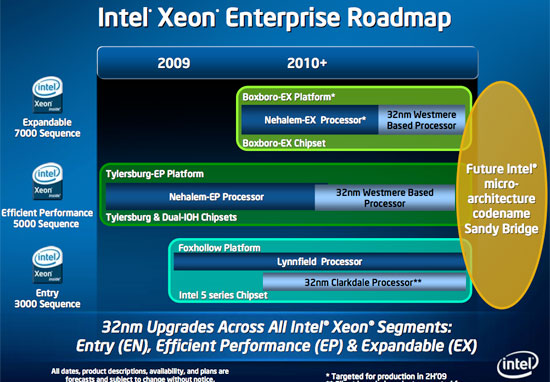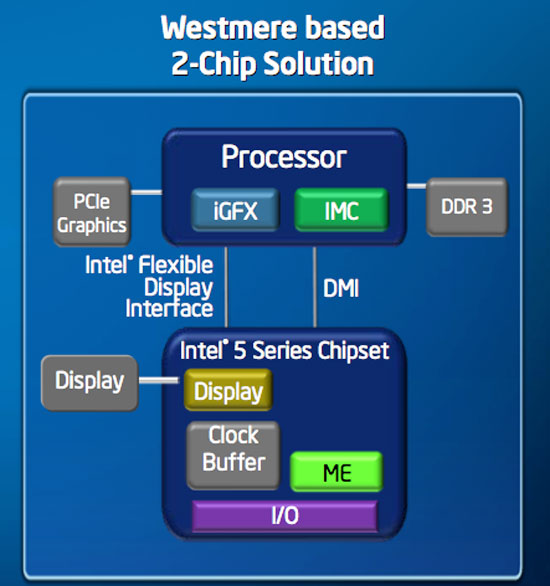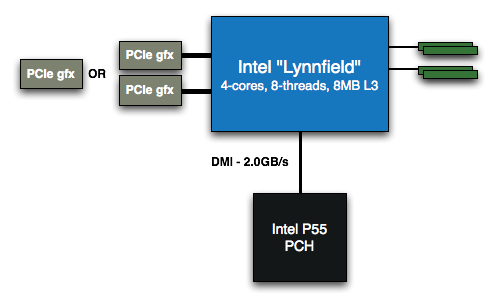Intel's 32nm Update: The Follow-on to Core i7 and More
by Anand Lal Shimpi on February 11, 2009 12:00 AM EST- Posted in
- CPUs
The Server Roadmap
Intel’s 32nm server roadmap is notably different from the desktop roadmap. Nehalem-EX will ship into the Xeon 7000 series as an 8-core, 16-thread part. It will eventually get replaced sometime in 2010 with a 32nm Westmere derivative.

We’ll see a 32nm six-core Westmere based processor in the Xeon 5000 series in 2010.
Finally Lynnfield and Clarkdale will be carried over to the entry level Xeon platforms at the end of this year and into 2010.
What About Chipsets?
Intel’s X58 chipset will remain the top dog through 2010. Chances are that we won’t see it replaced until the next tock with Sandy Bridge. Now that isn’t to say that the six-core 32nm Gulftown will work in existing X58 motherboards; while that would be nice, Intel does have a habit of forcing motherboard upgrades, we’ll have to wait and see.
The rest of the Nehalem/Westmere family will rely on Intel’s upcoming P55 chipset:

Originally both Lynnfield and Havendale were to have an on-package PCIe controller, I’m not sure if that has changed with the Havendale cancellation but I see no reason for it to have. In which case a Lynnfield system will still look like this:











64 Comments
View All Comments
strikeback03 - Wednesday, February 11, 2009 - link
Might depend on who you buy the motherboard from. My motherboard is a P965 and is not Penryn compatible, though other P965 boards are. There might be both hardware (say, power delivery) and software (BIOS) considerations to future generation processors.haukionkannel - Wednesday, February 11, 2009 - link
Wery little change. Intel ghange their soccets when they do new architechture prosessor. Only reason would be that AMD would be so cpmpetative that there would be a real prize war... By making new soccet they can make more money!Nfarce - Wednesday, February 11, 2009 - link
"Now that isn’t to say that the six-core 32nm Gulftown will work in existing X58 motherboards; while that would be nice, Intel does have a habit of forcing motherboard upgrades, we’ll have to wait and see." Unfortunately, my trusty nearly three year old E6600/ASUS P5W croaked and I need a new build *now* (my PS3 is no real sub for PC gaming :p ). I was going to just go cheap and build an E8500/P45 rig, but after reading this, I'm debating whether I should just go ahead and throw down the extra several hundred on an i7 build for future upgrade insurance. I'm leaning more towards the latter.CSMR - Wednesday, February 11, 2009 - link
Great article; nice work putting it together so fast!weevil - Wednesday, February 11, 2009 - link
My question is this. I've got a QX9650 at 3.2ghz on an x38 asus P5E3 Deluxe. Is it worth upgrading anytime this year to the i7 or am I fast enough to hold out until the Quad Core Gulftown rolls around in early 2010?Decisions decisions...
ssj4Gogeta - Wednesday, February 11, 2009 - link
Gulftown is 6 cores. :)weevil - Wednesday, February 11, 2009 - link
Yikes!Yummy ; )
dickeywang - Wednesday, February 11, 2009 - link
I guess I'll just keep my Thinkpad T61p (Merom T7300) for another 10 months. Thanks AnandTech.ssj4Gogeta - Wednesday, February 11, 2009 - link
I think this is a very good move.Want the highest end? Go for i7 now and upgrade to Gulftown hexa-core next year.
Want a mainstream quad? buy lynnfield at the end of this year and upgrade to Sandy Bridge at the end of the next year.
Are satisfied with your E8x00, or another dual core and think quad-core is a waste of money? Go for Clarckdale at the end of this year.
Want to buy a notebook? The 32nm Arrandale will deliver excellent performance with great power savings and an on package graphics processor for even more power saving.
Want to buy a powerful quad-core notebook? Go for Nehalem based Clarcksfield 45nm, which should deliver quite a lot of performance over current mobile CPU's, with Nehalem's power saving features as well, but not as much power savings as Arrandale.
7Enigma - Wednesday, February 11, 2009 - link
I'm a bit dissapointed that the next top of the line chip will be 6-core instead of a pumped quad. We are still in multi-core infancy with very few programs taking advantage of anything over dual-core, and almost nothing taking FULL advantage of quad-core. I just don't see how 6-core will be more beneficial than a higher clocked 4-core...As it stands, however, if the power efficiency is legit my next computer may very well be a laptop.